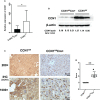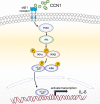CCN1 Promotes Inflammation by Inducing IL-6 Production via α6β1/PI3K/Akt/NF-κB Pathway in Autoimmune Hepatitis
- PMID: 35547732
- PMCID: PMC9084230
- DOI: 10.3389/fimmu.2022.810671
CCN1 Promotes Inflammation by Inducing IL-6 Production via α6β1/PI3K/Akt/NF-κB Pathway in Autoimmune Hepatitis
Abstract
Autoimmune hepatitis (AIH) is a chronic inflammatory liver disease with unknown etiology. CCN1, an extracellular matrix-associated protein, is associated with carcinoma, inflammation, liver fibrosis, and even autoimmune diseases. However, the role that CCN1 plays in AIH has remained undetermined. In this study, expression of CCN1 in liver was detected by real-time PCR, western blot and immunohistochemistry (IHC). CCN1 level in serum was detected by ELISA. Diagnostic value of CCN1 was determined by receiver operating characteristic (ROC) curve analysis. CCN1 conditional knockout (CCN1 fl/fl Cre+) mice were generated by mating CCN1 fl/fl C57BL/6J and CAG-Cre-ERT C57BL/6J mice. Autoimmune hepatitis mice model was induced by concanavalin A (ConA). IKKα/β, IκBα, NF-κB p65 and Akt phosphorylation were determined by western blot. NF-κB p65 nuclear translocation was examined by immunofluorescence. Here, we found that CCN1 was over-expressed in hepatocytes of AIH patients. CCN1 level also increased in serum of AIH patients compared to healthy controls (HC). ROC curve analysis results showed that serum CCN1 was able to distinguish AIH patients from HD. In ConA induced hepatitis mice model, CCN1 conditional knockout (CCN1 fl/fl Cre+) attenuated inflammation by reducing ALT/AST level and IL-6 expression. In vitro, CCN1 treatment dramatically induced IL-6 production in LO2 cells. Moreover, the production of IL-6 was attenuated by CCN1 knockdown. Furthermore, we showed that CCN1 could activate IL-6 production via the PI3K/Akt/NF-κB signaling pathway by binding to α6β1 receptor. In summary, our results reveal a novel role of CCN1 in promoting inflammation by upregulation of IL-6 production in AIH. Our study also suggests that targeting of CCN1 may represent a novel strategy in AIH treatment.
Keywords: AIH (autoimmune hepatitis); CCN1 (cellular communication network factor 1); IL-6 (interleukin 6); NF-kappa B; inflammation.
Copyright © 2022 Jiang, Tang, Zhang, He, Yu, Chen, Xia, Lin and Ou.
Conflict of interest statement
The authors declare that the research was conducted in the absence of any commercial or financial relationships that could be construed as a potential conflict of interest.
Figures








Similar articles
-
Ethyl acetate extract from Herpetospermun cardigerum wall. Ameliorated concanavalin A-induced autoimmune hepatitis in mice by reprofiling gut microenvironment to modulate IDO1/KYN and PI3K/AKT/NF-κB pathways.J Ethnopharmacol. 2025 Apr 9;345:119578. doi: 10.1016/j.jep.2025.119578. Epub 2025 Mar 11. J Ethnopharmacol. 2025. PMID: 40081510
-
Shear-Induced CCN1 Promotes Atheroprone Endothelial Phenotypes and Atherosclerosis.Circulation. 2019 Jun 18;139(25):2877-2891. doi: 10.1161/CIRCULATIONAHA.118.033895. Epub 2019 Mar 28. Circulation. 2019. PMID: 30917686
-
CCN1 upregulates IL-36 via AKT/NF-κB and ERK/CEBP β-mediated signaling pathways in psoriasis-like models.J Dermatol. 2023 Mar;50(3):337-348. doi: 10.1111/1346-8138.16611. Epub 2022 Nov 14. J Dermatol. 2023. PMID: 36376243
-
Serum Biomarkers for Autoimmune Hepatitis Type 1: the Case for CD48 and a Review of the Literature.Clin Rev Allergy Immunol. 2022 Dec;63(3):342-356. doi: 10.1007/s12016-022-08935-z. Epub 2022 Jun 3. Clin Rev Allergy Immunol. 2022. PMID: 35657576 Review.
-
Autoimmune Hepatitis and Fibrosis.J Clin Med. 2023 Mar 2;12(5):1979. doi: 10.3390/jcm12051979. J Clin Med. 2023. PMID: 36902767 Free PMC article. Review.
Cited by
-
CCN1-Mediated Signaling in Placental Villous Tissues after SARS-CoV-2 Infection in Term Pregnant Women: Implications for Dysregulated Angiogenesis.Curr Issues Mol Biol. 2024 Apr 18;46(4):3533-3550. doi: 10.3390/cimb46040221. Curr Issues Mol Biol. 2024. PMID: 38666951 Free PMC article.
-
Therapeutic Effect of Costunolide in Autoimmune Hepatitis: Network Pharmacology and Experimental Validation.Pharmaceuticals (Basel). 2023 Feb 17;16(2):316. doi: 10.3390/ph16020316. Pharmaceuticals (Basel). 2023. PMID: 37163367 Free PMC article.
-
The protective effects of aqueous extract of Schisandra sphenanthera against alcoholic liver disease partly through the PI3K-AKT-IKK signaling pathway.Heliyon. 2024 Jul 6;10(13):e34214. doi: 10.1016/j.heliyon.2024.e34214. eCollection 2024 Jul 15. Heliyon. 2024. PMID: 39091943 Free PMC article.
-
Environmental pollutants and phosphoinositide signaling in autoimmunity.J Hazard Mater. 2024 Mar 5;465:133080. doi: 10.1016/j.jhazmat.2023.133080. Epub 2023 Dec 1. J Hazard Mater. 2024. PMID: 38091799 Free PMC article. Review.
-
CD4+ T-cell subsets in autoimmune hepatitis: A review.Hepatol Commun. 2023 Sep 11;7(10):e0269. doi: 10.1097/HC9.0000000000000269. eCollection 2023 Oct 1. Hepatol Commun. 2023. PMID: 37695088 Free PMC article. Review.
References
-
- Mack CL, Adams D, Assis DN, Kerkar N, Manns MP, Mayo MJ, et al. . Diagnosis and Management of Autoimmune Hepatitis in Adults and Children: 2019 Practice Guidance and Guidelines From the American Association for the Study of Liver Diseases. Hepatology (2020) 72(2):671–722. doi: 10.1002/hep.31065 - DOI - PubMed
MeSH terms
Substances
LinkOut - more resources
Full Text Sources

